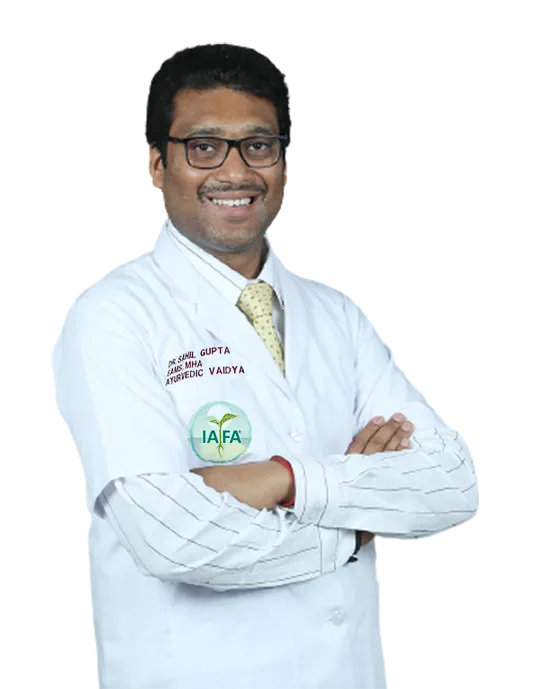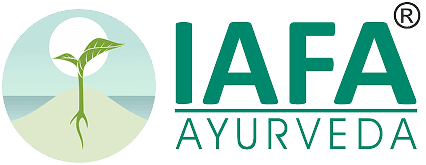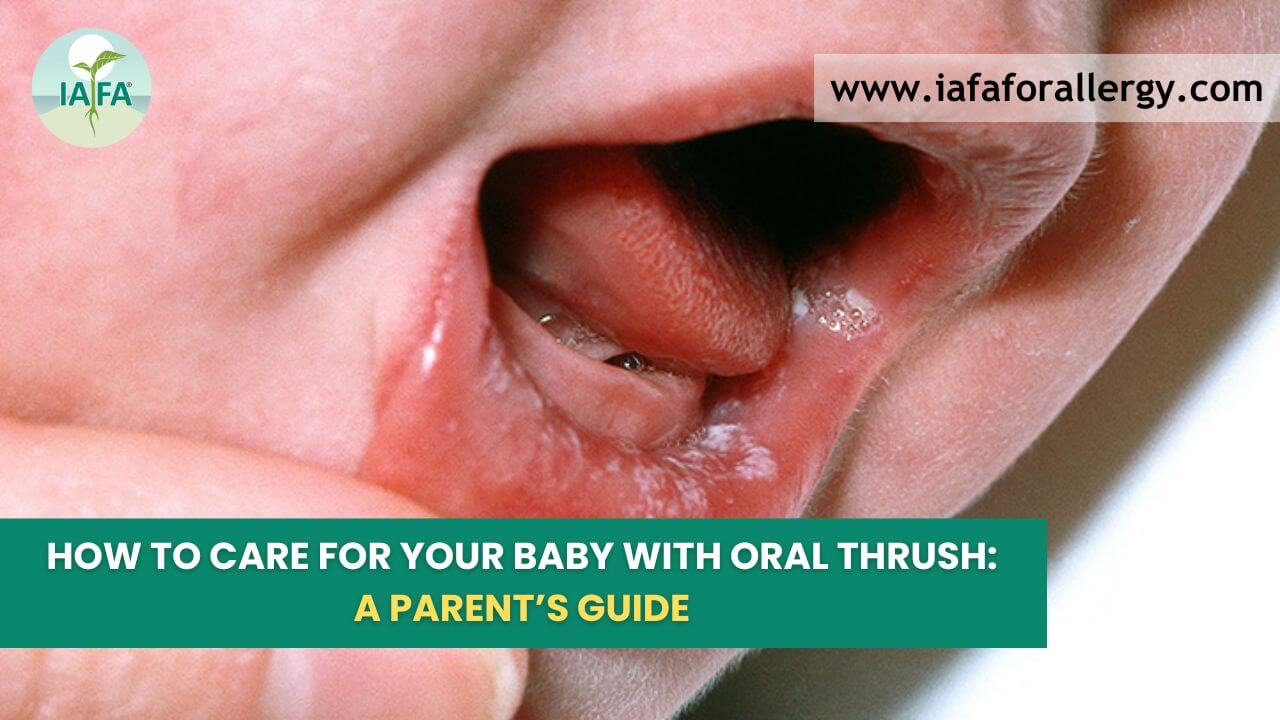Does your baby cry more than usual when you feed? And have you noticed white patches (which look like cottage cheese) inside your baby’s mouth?
Relax. This is Oral Candidiasis, also called Oral Thrush, which is a common oral fungal infection in babies. Though oral thrush in babies is not a serious medical condition, the infection can make your baby quite uncomfortable.
IAFA Ayurveda brings you gentle, safe, and effective Ayurvedic solutions, all age-appropriate and rooted in timeless wisdom, to care for your child with the softness they deserve.
Symptoms of Oral Thrush in Babies
Since babies can’t express their discomfort, it’s not easy to find out what they are going through.
Sometimes white residue in your baby’s mouth is milk residue, but you should know the difference between milk residue and oral thrush. Let me differentiate you both.
- Milk residue is concentrated on the tongue only, whereas yeast infection can be on the tongue, cheeks’ inner walls, gums, and roof.
- You can easily wipe off milk residue from your baby’s mouth, but the yeast patches stay in place.
Other symptoms to find out if it’s oral thrush in your baby or not –
- Cracks and bleeding around the corners of the mouth.
- White patches on the tongue, cheek, lips, gums, or roof of the mouth.
- Your baby has difficulty swallowing or sucking the milk.
- Crying with discomfort
Parents often notice their baby resuming normal feeding, with visible comfort in just a few days when gentle Ayurvedic care is provided.
Causes of Oral Thrush in Babies
Oral thrush is a fungal infection caused by a yeast called Candida albicans. It is a naturally occurring fungus present in our bodies.
Oral thrush in babies is very common because newborns have low immunity, or maybe your baby is on antibiotics to treat any bacterial infections, which makes them more prone to oral thrush than others.
Candida that is present in the gut can thrive and overgrow in the oral region (if immunity is low), resulting in white patches or cracks in the mouth.
Ayurvedic Approach to Oral Candidiasis in Babies
According to Ayurveda, oral thrush in babies is due to an imbalance of Kapha and Pitta doshas. Ayurveda correlates them with Bala Mukha Paka, Kaphaja Mukha Roga, or Talu Paka.
The main causes (Nidana) as per the Ayurveda are –
- Impure or heavy breast milk (Ksheera Dosha)
- Indigestion in the baby (Ajirna)
- Incompatible feeding habits(Abhyavahara Viruddha)
- Cold and heavy foods in the mother’s diet (Sheeta-Snigdha Ahara)
- Poor oral hygiene (Mukhadhvamsa)
- Microbial infection (Kaphaja Mukha Roga) caused by microorganisms (Krimis) is described in some ayurvedic texts like the Charaka Samhita, Sushruta Samhita, and Ashtanga Hridaya.
Treatment for Oral Thrush in Babies
Ayurveda aims to avoid the causative factors (Nidana Parivarjana), and various Ayurvedic treatment approaches are employed for this purpose. They are as follows:
1) Topical Application (Pratisarana/ Lepa)
1. Yastimadhu (Licorice/ Glycyrrhiza glabra) with organic honey (Madhu)
- How to use: Mix a pinch of Mulethi/ Licorice powder with a drop of honey. Apply gently on the tongue and inner cheeks with a cotton bud or clean fingers.
- Caution: Avoid use of honey babies below 6 months. Use breastmilk instead of honey or boil Yashtimadhu in water till liquid remains half(called decoction), cool it down and apply.
- How it works: Candida albicans is the main fungus responsible for oral thrush in babies. Yashtimadhu contains active ingredients like glabridin and glycyrrhizin, which inhibit the growth and biofilm formation of Candida species.
2. Triphala powder with honey
Triphala is a combination of three fruits – Haritaki (Terminalia chebula), Bibhitaki (Terminalia bellirica), and Amalaki (Emblica officinalis) which contain antimicrobial and anti-inflammatory properties. Triphala is highly effective in curing oral thrush in babies.
- How to use: Mix a pinch of Triphala powder with a drop of honey. Apply gently on the effected area using a cotton bud or cleaned fingertip.
- Caution: Avoid use of honey babies below 6 months. Use breastmilk instead of honey or boil Triphala in water till liquid remains half(called decoction), apply when the mixture is cool down.
- How it works: Triphala powder contains tannins, gallic acid, chebulinic acid, and flavonoids. These compounds interfere with fungal cell wall integrity to stop it from forming a sticky layer in the mouth.
Triphala also exhibits anti-inflammatory effects, which promote wound healing by repairing tissues and supporting new cell growth through collagen synthesis and epithelial regeneration.
2) Decoction (Kashaya) for Oral Cleaning
1. Haridra (Turmeric) water
Haridra, known as Curcuma longa, is used as a decoction for oral cleaning. Decoction is the process of boining a herb in water and using it when it cools down.
- How to use: Add a pinch of organic Haridra powder (Turmeric powder) to boiled water and cool it. Use a clean cotton swab for oral cleaning to apply gently to lesions.
- Caution: You should dilute turmeric water to avoid irritation or staining. Avoid in babies below 6 months of age.
- How it works: Haridra is known as an anti-microbial (Krimighna) and wound healing (Ropana) herb. Turmeric possesses anti-fungal, anti-inflammatory, and antioxidant properties. Active constituents in curcumin damages yeast’s cell membrane and its mitochondrial functions to kill Candida albicans cells.
2. Narikela (coconut) water
Tender coconut water is cooling, pH-balancing, and acts as a natural antifungal agent.
- How to use: Dip sterile gauze in fresh coconut water and gently wipe the inner cheeks and baby’s tongue with it. It is safe for babies of all ages, even babies below 6 months of age.
- Caution: Use only unfermented, fresh tender coconut water
- How it works: Coconut water is naturally sterile and contains lauric acid, monolaurin, and phenolic compounds. These are lipid-disrupting agents that restrict fungus growth. Coconut water is mildly alkaline, and candida needs an acidic environment for thriving, making it tough for the yeast to survive. Coconut water also gives gentle hydration to inflamed tissues and soothes the wounds.
3. Breast Milk
Breast milk is rich in IgA antibodies and possesses anti-fungal activity.
- How to use: Express a few drops of breast milk and dab it onto the baby’s tongue and oral mucosa with a sterilized finger or gauze. It is safe for all ages.
- How it works: IgA antibodies present in milk binds with candida antigens and prevents them from attaching to the oral mucosa. The breast milk also forms a protective coating over the baby’s mucous membranes.
Breast milk also contains lactoferrin, which is an antifungal glycoprotein that directly disrupts candida cell membranes and inhibits its growth. Mother’s milk also contains HMO (Human Milk Oligosaccharides), which acts as a prebiotic that supports good bacteria to keep the mouth healthy.
4. Neem decoction
Neem has Kapha and Pitta balancing properties, along with anti-fungal activity.
- How to use: Take 1-2 tender leaves of Neem and prepare a mild decoction in 1 cup of water. Let it cool and use it to wipe the mouth lightly.
- How it works: Neem leaves consist of various active ingredients like nimbidin, geducin, and azadirachtin, which inhibit fungal hyphae growth and spore formation. It also acts as an anti-inflammatory and promotes mucosal repair by increasing collagen synthesis.
3) Internal Medication (Under Medical Supervision)
These Ayurvedic medications can be used in infants above 6 months under medical supervision:
- Guduchi Satva (50-100mg- Dosage may vary) with breast milk for reducing infection and to exhibit immunomodulatory effects.
- Draksha Arishta 2- 3drops with water to support recovery and improve digestive fire (Agni).
Many parents see reduced patches and comfortable feeding within a few when consistent home care aligns with Ayurvedic treatment.

Dr. Sahil Gupta has helped hundreds of infants recover from oral thrush through gentle Ayurvedic care that clears fungal patches, boosts immunity, and restores comfortable feeding.
Many parents notice improvement in just a few days of following the treatment.
If your child is experiencing Oral Thrush from long time, you can consult Dr. Sahil Gupta for safe, root-cause Ayurvedic treatment.
– Dr. Sahil Gupta (B.A.M.S., M.H.A.)
Ayurvedic Allergy Specialist
CEO & Founder of IAFA®
How to Prevent Thrush in Babies
You can prevent oral thrush in babies by providing nutrition, ayurvedic treatments and maintianing hygiene. Hygiene is applicable both babies as well as mother. Lets discuss how to prevent thrush in babies in detail.
In case of nutrition, breastfeed is the best supplement that you can give to your baby. Your milk contains all the essential nutrients required for your baby’s immunity and growth. Let’s discuss the prevention measures now.
1) Prevention measures for babies
- Oral Hygiene: Always remove leftover milk from the baby’s mouth and gums by cleaning them with a soft, damp cloth after feeding to reduce fungal overgrowth.
- Sterilization & Hygiene Practices: Always boil nipples, bottles, and pacifiers after every use. Dry wet pacifiers and nipples before storing them.
You should also wash soft toys on regular basis. - Gentle Air Exposure: Let your baby’s mouth stay open for a few seconds or encourage gentle burping without closing the mouth right away so that air can circulate and help in reducing fungal growth.
- Cleanliness: Wash your baby hands often as they keep putting their finger in their mouths.
Also Read: 5 Amazing Home Remedies for Fungal Infections
2) Prevention measures for mothers
Mothers can also get infected from a child suffering from oral thrush.
Firstly, it’s more important to check whether the mother of the infant has any candida infection if the infant is breastfed. Because infections can keep passing back and forth between mother and baby, so addressing the mother’s condition is essential to prevent oral thrush in babies.
If the mother has a candida infection, the symptoms can be as follows:
- Burning or pain during nursing.
- Cracks or bleeding around the nipples.
- Painful breastfeeding even when the baby latches correctly
You can go for natural ayurvedic medicines as they can be safe for lactating mothers and children. This can be harmful as the infant and mother both may get back and forth infections transmitted from one another, so the mother must get treated first to prevent oral thrush in babies.
- Clove Water: You can use mild clove water (boil 1-2 cloves in one glass of water and let it cool down) as a mouth rinse. This helps in reducing yeast growth in the mother’s mouth, which indirectly prevents reinfection through kissing.
- Coconut Oil or Olive Oil: Gently rub coconut oil or olive oil over the areola or nipples. Both coconut oil and olive oil have antifungal properties which can help in relieving from thrush.
- Honey: Honey possess excellent antifungal properties and you can directly apply on your nipples. Clean them before breastfeeding because of the risk of botulism, you should avoid giving it to your baby under 6 months.
Medihoney is a medical-grade honey that doesn’t cause botulism and gives the patient relief from thrush too. It is safe to consume and prevent oral thrush in babies. - Breast Hygiene: Frequent cleaning of breasts with natural soap and warm water can help to prevent microbial growth which can reduce the symptoms of thrush.
- Biotin is a rich source of immunity-boosting properties, pregnant women will be deficient in biotin, so taking biotin supplements can help in fighting candida infections and prevent thrush.
- Refrigrate breast milk If you are storing it.
- Sterilize the towels, utensils, bras, breast pump parts, and all the other things that come in direct contact with you and your baby.
If the you got any fungal infection, then you can use above discussed herbal medicines and prevention tips to secure your baby from infection. You can also go for home remedies that I’ll tell you in the next section.
Home Remedies for Oral Thrush in Babies
If you’re wondering how to get rid of thrush in babies naturally, here are the home remedies that can help control fungal infection in both you and your baby.
- Breast Milk Application: Apply directly on inner cheeks and baby’s tongue a few drops of breast milk after feeding, which controls yeast growth by anti-fungal and natural antibodies.
- Coconut Oil: Dab a tiny amount of virgin, cold-pressed coconut oil on a cotton swab or clean finger and apply a thin layer on the inner cheeks and baby’s tongue. Coconut oil contains caprylic and lauric acid, both act as antifungal agents.
- Probiotics (with Pediatrician’s Approval): Safe probiotics like Lactobacillus reuteri can help restore healthy oral and gut bacteria balance. Discuss with pediatrician before using.
- Apple Cider Vinegar (ACV) for Mother: Avoid giving to babies directly, but you can use it to rinse their nipple before the next feed to reduce yeast growth on the skin. Apple cider vinegar has antibacterial properties which helps in curing sore nipples.
- Salt Water (Mild Saline) for Mother: If you have sore nipples, you can rinse them with mild salt-water that will not only sooth your nipples but also discourage the fungus growth.
Conclusion
Oral thrush in babies is common and usually nothing to worry because natural remedies and Ayurvedic medicines can make a big difference. If symptoms persist or get worse, it’s always best to consult an Ayurvedic doctor becasue Ayurveda is absolutely safe for both you and your kid.
IAFA Ayurveda brings you gentle, safe, and effective Ayurvedic solutions to care for your child with the softness they deserve.
Frequently Asked Questions
Q1. What newborn behaviors most strongly predict developing oral thrush?
Ans. Crying with high discomfort and your baby has difficulty in swallowing the milk.
Q2. Which cleaning routines reduce reinfection between baby and breastfeeding parent?
Ans. Oral hygiene, mother’s hygiene along with sterlizing bottles, nipples and similar products.
Q3. How should I adjust feeding and hygiene during a thrush treatment period?
Ans. Clean your nipples after every feed and keep your baby’s mouth and hands clean multiple times a day to avoid any infection.
Q2. Which cleaning routines reduce reinfection between baby and breastfeeding parent?
Ans. Oral hygiene, mother’s hygiene along with sterlizing bottles, nipples and similar products.
Q4. Which home remedy can I use alongside prescribed nystatin?
Ans. Using coconut oil is the best remedy as it doesn’t interfere with other treatments.
Q5. How should I clean bottles and pacifiers to prevent reinfection?
Ans. Sterlize them by boiling them in water.
Q6. What signs mean home care is failing and I need urgent doctor care?
Ans. Your baby stop having your milk, constant crying and cracked nipples are some symptoms that require urgent doctor care.
Q7. Can breastfeeding parents use the same home remedies on their nipples?
Ans. Yes in most of the cases except avoid using apple cider vinegar or honey as they can’t be digested by their rivals.
Q8. Does Every Baby Get Affected by Oral Thrush?
Ans.









